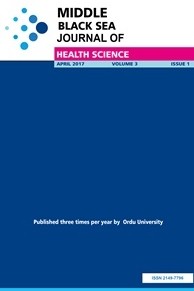Evaluation of Sleep Quality of Anesthesiologists Working in Turkey
pittsburg sleep quality index, Pittsburgh sleep quality index
Evaluation of Sleep Quality of Anesthesiologists Working in Turkey
___
- 1. Elbi H, Bayraktar H. Uyku Bozuklukları. In: Çelikol A, editor. Uyku Bozukluklarına tarihsel yaklaşım ve sınıflama. Ege Üniversitesi Basımevi; 1996. p. 7–12.
- 2. American Academy of Sleep Medicine. International classification of sleep disorders. 2nd ed. Westchester: Illinois: American Academy of Sleep Medicine; 2005.
- 3. Fisch BJ. Neurological aspects of sleep. In: Aminoff MJ, editor. Neurology and general medicine. 2nd ed. USA: Churchill Levingstone; 1995. p. 491–520.
- 4. Buysse DJ, Reynolds CF, Monk TH, Berman SR, Kupfer DJ. The Pittsburgh Sleep Quality Index: a new instrument for psychiatric practice and research. Psychiatry Res.1989 May;28(2):193-213.
- 5. Agargün MY, Kara H, Anlar Ö. Pittsburgh Uyku Kalitesi İndeksi’nin Geçerliği ve Güvenirliği. Türk Psikiyatr Derg. 1996;7(2):107–15.
- 6. Saricaoğlu F, Banu AKINCI S, Gözaçan A, Güner B, Rezaki̇ M, Aypar Ü. Gece ve Gündüz Vardiya Çalışmasının Bir Grup Anestezi Asistanının Dikkat ve Anksiyete Düzeyleri Üzerine Etkisi
- 7. Ganesan S, Magee M, Stone JE, Mulhall MD, Collins A, Howard ME, et al. The Impact of Shift Work on Sleep, Alertness and Performance in Healthcare Workers. Sci Rep. 2019 [Nov 27];9(1).
- 8. Costa G. Factors influencing health of workers and tolerance to shift work. Theor Issues Ergon Sci. 2003 Jul;4(3–4):263–88.
- 9. Boivin DB, Boudreau P. Impacts of shift work on sleep and circadian rhythms. Pathol Biol. 2014 ;62(5):292–301.
- 10. Nena E, Katsaouni M, Steiropoulos P, Theodorou E, Constantinidis TC, Tripsianis G. Effect of Shift Work on Sleep, Health, and Quality of Life of Health-care Workers. Indian J Occup Environ Med. 2018;22(1):29.
- 11. Murray D, Dodds C. The effect of sleep disruption on performance of anaesthetists- A pilot study. Anaesthesia. 2003 ;58(6):520–5.
- 12. Nelson KL, Davis JE, Corbett CF. Sleep quality: An evolutionary concept analysis. Nurs Forum. 2022;57(1):144–51.
- 13. Scott AJ, Webb TL, Martyn-St James M, Rowse G, Weich S. Improving sleep quality leads to better mental health: A meta-analysis of randomised controlled trials. Sleep Med Rev. 2021;60.
- 14. Nelson KL, Davis JE, Corbett CF. Sleep quality: An evolutionary concept analysis. Nurs Forum. 2022;57(1):144–51.
- 15. Krystal AD, Edinger JD. Measuring sleep quality. Sleep Med. 2008;9 Suppl 1.
- 16. McCall C, McCall WV. Objective vs. Subjective Measurements of Sleep in Depressed Insomniacs: First Night Effect or Reverse First Night Effect? J Clin Sleep Med. 2012 Jan 1];8(1):59.
- 17. Ohayon M, Wickwire EM, Hirshkowitz M, Albert SM, Avidan A, Daly FJ, et al. National Sleep Foundation’s sleep quality recommendations: first report. Sleep Heal. 2017;3(1):6–19.
- 18. Watson NF, Badr MS, Belenky G, Bliwise DL, Buxton OM, Buysse D, et al. Joint Consensus Statement of the American Academy of Sleep Medicine and Sleep Research Society on the Recommended Amount of Sleep for a Healthy Adult: Methodology and Discussion. J Clin Sleep Med. 2015;11(8):931.
- Yayın Aralığı: Yılda 4 Sayı
- Başlangıç: 2015
- Yayıncı: Ordu Üniversitesi
Özgür KILIÇ, Mehmet POLAT, Kamil SANNAH, Melda DİLEK
Mehmet Zeki YILMAZTEKİN, Osman KAYAPİNAR, Gülşah AKTÜRE, Gökhan COŞKUN, Muhammet AŞIK, Hamdi AFŞİN
Evaluation of Sleep Quality of Anesthesiologists Working in Turkey
Zübeyir CEBECİ, Ebru CANAKCİ, Nilay TAŞ, İlker COŞKUN
May the Systemic Immune-Inflammation Index be an Indicator of Premature Ovarian Insufficiency?
Are Prostate Cancer Screenings Performed in Compliance with Cancer Guidelines?
İsmail NALBANT, Erdal BENLİ, Abullah ÇIRAKOĞLU, Mevlüt KELEŞ, İbrahim YAZICI, Ahmet Anıl ACET
Radiological Evaluation of the Relationship Between Plantar Fasciitis and Foot Arch Angles in Adults
Mehmet BOZ, Abdullah Alper ŞAHİN, Mehmet AKÇİÇEK
The Effect of Vitamin Use During Pregnancy on First Tooth Eruption Time in Postpartum Period
Zeynep BAYRAMOĞLU, Gamze Nur CİMİLLİ ŞENOCAK, Munevver KILIÇ, Kamber KAŞALİ
Nilüfer ERENLER, Emine PİRİM GÖRGÜN
Ezgi SUMER, Gülşah ÇIKRIKÇI IŞIK, Şeref Kerem ÇORBACIOĞLU, Yunsur ÇEVİK
